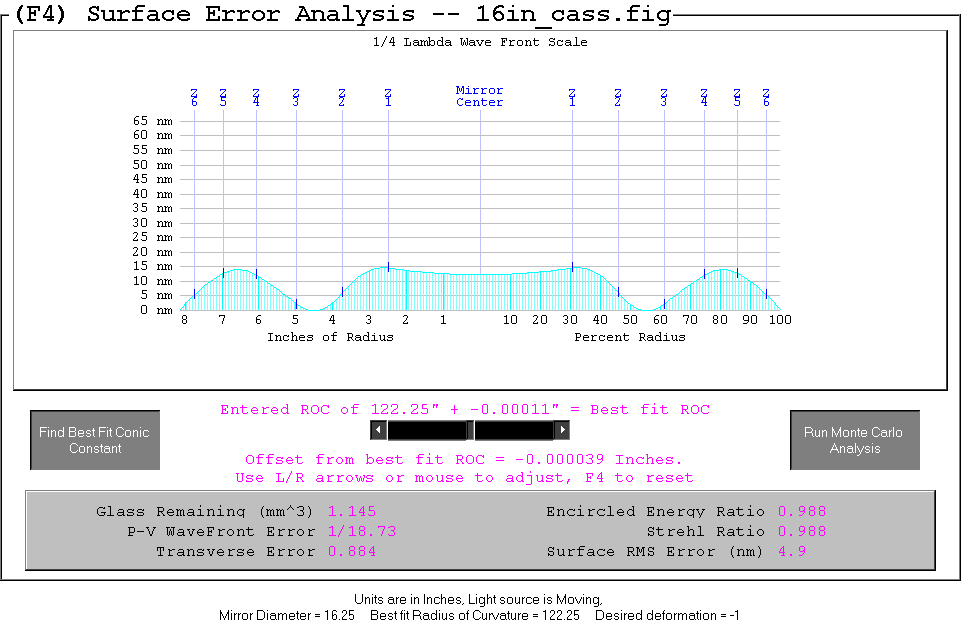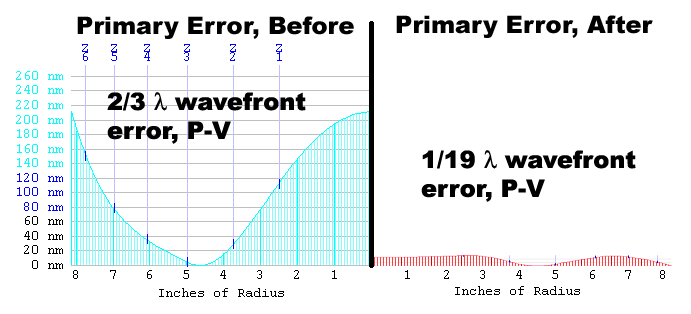Primary Mirror Refiguring -
DONE!
Starting condition, background
As it turned out, the primary mirror was approximately 90% corrected,
and had a wavefront error of 2/3 waves. This was not good.
Refiguring work includes adding correction, smoothing out the surface
even more (on the micro-scale), and obtaining as finely polished an
optical surface that I can to minimize scatterred light and contrast
loss. The Cassegrain primary is already perforated and has a
focal ratio of F/3.77. This is fast, but after figuring a 30"
F/3.8, nothing seems that bad any more! For me, real difficulties
don't really crop up until below F/3.5 or so, so with careful work and
testing the primary will come out smooth and accurate.
The primary is the critical element in the Cassegrain, as it is the
largest, most strongly curved optical element. It generally
limits the performance of the instrument. Therefore, time must be
taken to make it with sufficient quality to provide excellent
high-contrast planetary images. (If the primary has problems,
you're doomed from the first reflection.)
Update, Oct. 10, 2004:
A pitch lap was prepared some time ago for use with the 16.25" F/3.77
primary. It is currently being used to
smooth the surface of the mirror.
Even as an ellipsoid, the mirror still had some zoniness that I have
been removing. The overall correction got significantly closer to
that of a parabola during this process. This is fine, as the
design will be a classical Cassegrain with a paraboloidal primary
mirror. It is easier for me to de-correct such a fast mirror than
to add correction to it, so there was no harm in making some forward
progress in this area.
I have also switched to a different polishing compound for finishing
and fine figuring. This has resulted in a better polish over the entire surface, and improve
reflectivity of the bare glass. Later on, this will improve
contrast, especially on planets. (For those that have observed
with my 16" F/4, you know what I'm talking about.)
In the process of doing the smoothing, I have learned how to make the
lap work over and around the central perforation of the mirror.
What remains now is simply to add the remaining correction and
comprehensively test the figure.
Update, Oct. 15, 2004:
I have added more correction to the mirror, and it now has a much
improved and what I would call an "acceptable" figure. There are
a few more areas that need some work, but most of the correction is in
place and tweaking remains. The wavefront error is now below 1/6
wave, and the entire surface is smooth to the point that I am finally
satisfied with it. Let the tweaking begin. Now I will wait
more than 12 hours between working and testing.
Update, Oct. 18, 2004:
As of this morning, the primary refiguring is complete! The final
specs are listed below, and after that is a graphical comparison of the
error on the glass surface, that was present before and after
refiguring. The improvement is quite marked. Note the low
transverse error. This work was accomplished entirely with a 6"
diameter pitch lap. I'll try to get some pictures of the knife
edge shadows to post here later on. Here are the specs:

Update, Oct. 20, 2004:
I have now touched up the bevel of the mirror in a few places, engraved
the mirror with relevant info, and cleaned it. It's ready for
coating.


